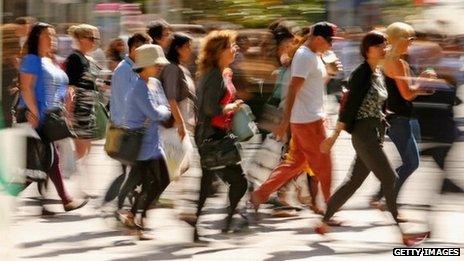Australia growth rate falls short of forecasts
- Published

Subdued domestic consumption has impacted Australia's latest growth numbers
Australia has reported weaker-than-expected growth for the July-to-September quarter partly due to slower domestic demand.
The nation's gross domestic product (GDP) expanded 0.6% compared to the previous quarter and 2.3% year-on-year.
Most analysts had forecast a quarterly growth of about 0.7% and an annual expansion of close to 2.6%.
Australia's economy has also been hurt by a global slowdown which has seen its mining boom wane recently.
"It looks like household consumption has probably been the main disappointment in the actual quarter," said Su-Lin Ong, an economist with RBC Capital Markets.
"It very much confirms the idea of an economy that is running around sub-trend pace and has a number of challenges," she added.
'Not good enough'
Australia's economic growth over the past few years has been powered by the success of its mining sector.
Booming demand for its commodities from emerging markets such as China and India helped the country wade through the global financial crisis.
However, a recent slowdown in growth in those economies has impacted the sector and as a result Australia's overall economic growth.
At the same time, despite efforts by policymakers, non-mining sectors of the economy have not grown fast enough to offset the slowdown in mining.
Treasurer Joe Hockey said the latest growth numbers were "not good enough to deliver the jobs that people want".
Michael Blythe, chief economist at Commonwealth Bank of Australia said: "The economy looks like it's still stuck in first gear."
"Mining investment is coming off, maybe not as quickly as people have been worrying about, but it's that growth transition, the pick-up in the non-mining side, where the evidence is still mixed," he added.
Growth boost?
The numbers come just a day after Australia's central bank left its key interest rate unchanged at a record low 2.75%
The Reserve Bank of Australia (RBA) last cut the rate in August, when it lowered borrowing costs by 0.25%.
On Tuesday, the bank said "the full effects of these decisions are still coming through".
Some analysts suggested that if growth continued to remain weak, the bank may be prompted to cut rates further to try to boost the economy.
"The RBA is obviously reluctant to cut further, but if you've got sub-trend growth and very well-behaved inflation, there's got to still be scope to move if necessary," said Ms Ong of RBC Capital Markets.
- Published3 September 2013
- Published25 August 2013
- Published4 September 2013